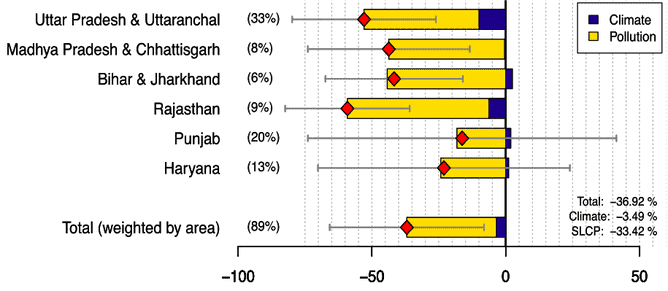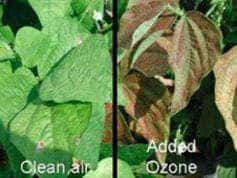Scientists have long known that climate change has a major negative impact on global agriculture, potentially even threatening global food security. But a new research shows that air pollution is actually much more threatening. Anthropogenic climate change caused 3.5% decrease in potential wheat yield on a country level in India; air pollution caused more than 32% decrease in potential yield.
Ozone and soot
Air pollution and soot are the main culprits for crops, with some states in India suffering from a 50% reduction in yields, and the odds are the same is happening in many parts of the world (at the same or at a smaller scale). Jennifer Burney and Veerabhadran Ramanathan from the University of California, San Diego systematically investigated the impact of air pollution and anthropogenic climate change on crops in India and found that on average, air pollution has caused a third of loss in wheat yield and one fifth of loss in rice yield in India in 2010, compared to a baseline from 1980.
Many previous papers have studied the impact of climate change in agriculture, and for good reason. A change as slight as one degree Celsius can spell disaster for cultures across the world. But according to this research, ozone and soot causes much more crop loss than climate change. From 1980 to 2010, the increase in temperature and change in precipitation as a result of anthropogenic climate change has caused a 3.5% decrease in wheat yield, while the above mentioned elements had a negative contribution of 32%.
Ozone is a powerful oxidant (far more so than dioxygen) and has many industrial and consumer applications related to oxidation. However, it’s this exact property which also makes it a pollutant, damaging not only human tissues, but also plant tissues. Soot is emitted mainly from burning plants and fossil fuels. It directly absorbs sunlight, reducing the amount of light available for crops to photosynthesise. Each of these two factors alone has caused more damage to crops than global warming.
Bad news and good news
This is, of course, bad news, especially as things aren’t going to get any better anytime soon. William Bloss, an expert in atmospheric chemistry, points out that background ozone levels have more than tripled since they were first monitored in the 1870s.
“Looking to the future”, he says, “models predict that ground level ozone will continue to rise in many areas of the world”. Ozone pollution will continue to be a major challenge for food security.
The good news is that if there is a desire to change things, the effects will be immediate. Air pollution (soot and ground level ozone) is short lived and immediate benefits can be seen as soon as action is taken – as opposed to carbon dioxide, which has much longer effects. This also means that there is a very strong incentive to address this type of pollution, and hopefully, policymakers will not turn a blind eye towards this.
Another noteworthy thing is that there were significant variations in the damage caused by soot. Some areas in India had a yield loss of over 50% which raises some important questions: Could the air pollution in China be causing the major increase in recent global food demand? Personally, I’d really love to see the same type of study conducted in China and other areas of the world.
Journal Reference: Jennifer Burneya and V. Ramanathanb. Recent climate and air pollution impacts on Indian agriculture. doi: 10.1073/pnas.1317275111












